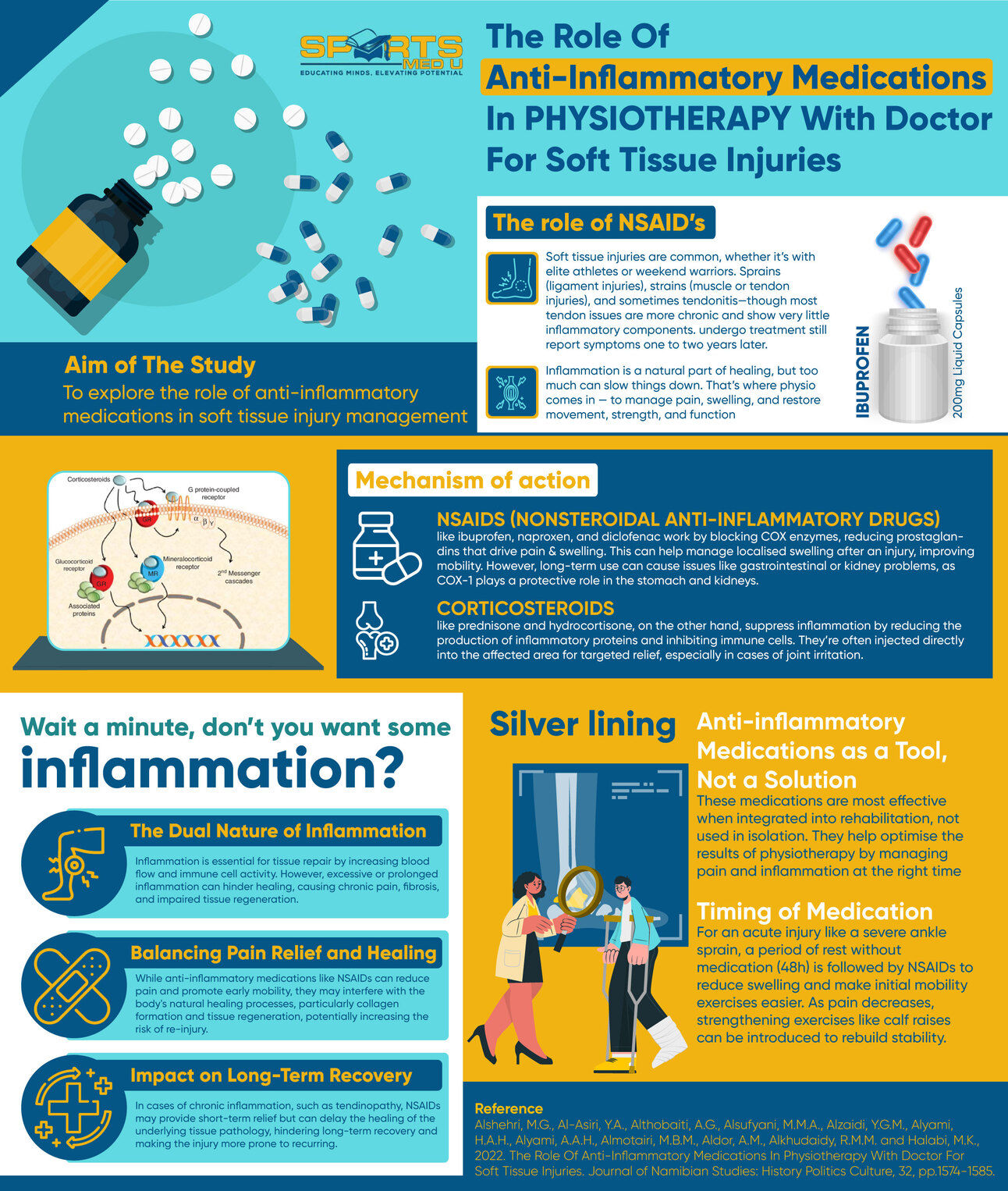- Sports Med U Newsletter
- Posts
- Pain Medication in Physio - 3 Takeaways
Pain Medication in Physio - 3 Takeaways
Sports Med U | Educating Minds, Elevating Potential
The Role Of Anti-Inflammatory Medications In Physiotherapy With Doctor For Soft Tissue Injuries
Alshehri, M.G., Al-Asiri, Y.A., Althobaiti, A.G., Alsufyani, M.M.A., Alzaidi, Y.G.M., Alyami, H.A.H., Alyami, A.A.H., Almotairi, M.B.M., Aldor, A.M., Alkhudaidy, R.M.M. and Halabi, M.K., 2022. The Role Of Anti-Inflammatory Medications In Physiotherapy With Doctor For Soft Tissue Injuries. Journal of Namibian Studies: History Politics Culture, 32, pp.1574-1585.
In today’s letter
Overview of how non-inflammatory medication can help in physiotherapy
A fun infographic for you to save and use in the future
Rapid Results =
NSAIDs can hinder the healing process in acute injuries and disrupt the stomach lining and renal function. However, it can also help with early mobilisation if used sensibly and strategically
3 resources to check out to further your knowledge about how NSAID help/hinder healing
Meme of the week: Sounds like you’re dying 😄
Bite-size study - Infographic style!

3 Takeaways
Aim of the study
The aim of the study is to explore the role of anti-inflammatory medications in soft tissue injury management, focusing on their mechanisms, benefits, risks, and integration with physiotherapy interventions to optimise treatment outcomes
Role of Anti-inflammatory Medications
Anti-inflammatory medications, like NSAIDs and corticosteroids, are powerful strategies in managing soft tissue injuries.
When someone experiences a sprain, strain, or tendon issues (More tendonitis, rather than tendinopathy —> aim not to use it with tendinopathies as theres limited inflammatory activity), inflammation can be both a symptom and a hindrance to recovery.
The medications target inflammation, helping patients to move more comfortably and begin physiotherapy sooner. For example, NSAIDs like ibuprofen can reduce swelling and discomfort, making it easier to perform rehab early.
Corticosteroids, often administered through injections, are particularly useful for severe or localised inflammation, such as in joint irriattions or bursas
The combination of medication and physiotherapy creates a synergistic effect: medications manage acute symptoms, while physiotherapy helps long-term functional recovery.
However, these medications should always be part of a holistic plan, not a stand-alone solution. Addressing the root causes of injury, such as poor biomechanics or repetitive stress, ensures that recovery is sustainable.

How do they work?
NSAIDs like ibuprofen and naproxen target enzymes called cyclooxygenase (COX-1 and COX-2), which help create prostaglandins—chemicals that cause inflammation, pain, and swelling. By blocking COX enzymes, NSAIDs reduce these symptoms, which have the potential to provide pain free movement.
Corticosteroids, on the other hand, operate at a deeper level. They bind to glucocorticoid receptors in cells, altering gene expression to suppress pro-inflammatory cytokines like IL-1 and TNF-α. This action not only reduces inflammation but also slows immune responses that could damage tissues.
Benefits & Pitfalls in Physiotherapy
Benefits:
Pain and swelling can make it difficult for patients to participate in the early stages of physiotherapy, where movement and mobility are critical. Medications like NSAIDs help breakdown these barriers, helping patients to go through rehab without excessive discomfort.
Early mobilisation is key as it prevents joint stiffness, muscle atrophy, and long-term functional limitations.
Additionally, corticosteroid injections can target stubborn or severe inflammation, creating a window of opportunity for physiotherapy to make a bigger impact.
For example, a patient with a painful shoulder bursa might struggle with exercises until inflammation is brought under control. The medication doesn’t just reduce symptoms—it actively improves the persons ability to go through their daily lives and (hopefully) help them be a little more happy.
The ultimate goal is to combine symptom management with the long-term benefits of physiotherapy.
Pitfalls:
One of the challenges in combining anti-inflammatory medications with rehabilitation is balancing symptom relief with the body’s natural repair processes. While reducing pain and swelling allows for early mobilisation—importnat for preventing stiffness and muscle atrophy—it may also slow collagen synthesis and delay the maturation of healing tissues.
For example, NSAIDs can improve short-term comfort, allowing patients to go through rehab. However, overuse may impair tissue strength or leave healing areas vulnerable to re-injury. Chronic conditions like tendinopathies show this issue well: while NSAIDs can provide quick symptom relief (not always), they may not resolve the underlying tissue damage, delaying true recovery and increasing the likelihood of recurrence.
The answer lies in moderation. Medications should support rehabilitation without replacing it, making sure that inflammation is controlled but not entirely suppressed.
In addition, NSAIDs, for example, can irritate the stomach lining, leading to gastritis or ulcers, especially with prolonged use or when taken on an empty stomach. Patients with existing conditions like acid reflux or kidney disease are particularly vulnerable.

Clinical Tip
Balance Pain Management and Tissue Healing
Use anti-inflammatory medications only in the acute phase (first 48-72 hours) to manage pain and swelling, but avoid prolonged use. Prolonged NSAID use can inhibit collagen synthesis and hinder tissue repair, especially in tendon injuries.
After the acute phase, you can try shifting the focus to manual therapy to promote by product clearance and blood flow without compromising tissue regeneration.
Timeframe: Use NSAIDs for short durations, no longer than 5-7 days, to manage acute symptoms. After this period, the emphasis should be on rehabilitation rather than pharmacological interventions.
Top 3 Resources to Check Out
And learn more about anti-inflammatory medication
Meme of The Week

Thank you for reading this weeks edition!
Have a browse through our articles to sharpen you diagnostic skills

Reply